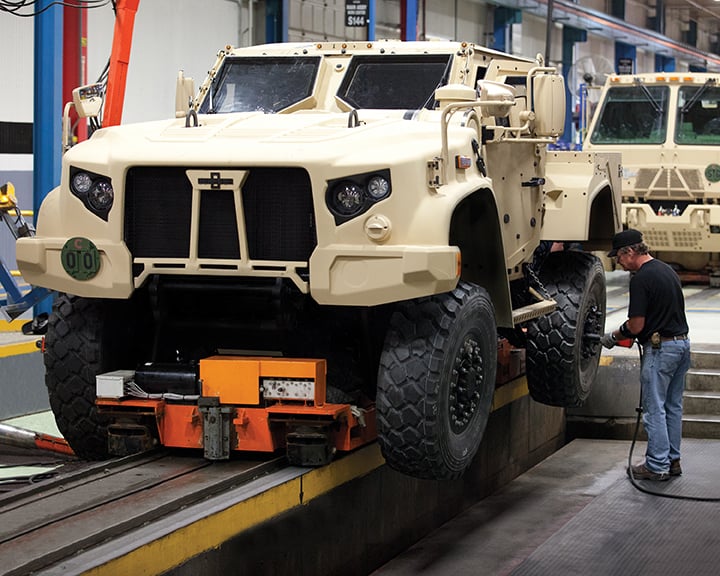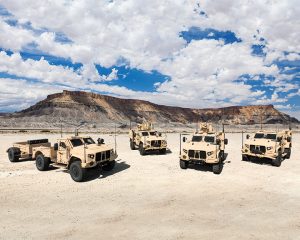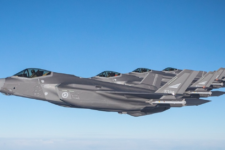
JLTV on the Oshkosh production line.
WASHINGTON: The Army’s already shared Oshkosh’s Joint Light Tactical Vehicle design with rival companies, who hope to take over the program when a new competition is held in 2022. But, having announced a new $911 million order just yesterday, Oshkosh Defense is confident that it’ll fend off all challengers and keep building JLTVs for years to come, general manager George Mansfield told me this morning.
“This contract really shows how the Joint Program Office feels about Oshkosh,” Mansfield said. “They’re very confident we build a good quality product, [and] we are on time and under budget so far.”

A JLTV fitted with a 30 mm autocannon and a Javelin anti-tank missile.
In fact, Mansfield said, Oshkosh JLTVs were coming in so much under budget that the military was able to buy more vehicles in less time than the original contract anticipated. (And it did so despite cuts to the JLTV budget in recent years). That’s why the Army — which runs JLTV on behalf of all the US armed services and seven foreign customers from Belgium to Brazil — had to issue the new contract this fall.
You see, in 2015, when Oshkosh beat aerospace titan Lockheed Martin and Humvee manufacturer AM General, the Army issued a production contract with a maximum value of $6.7 billion and a maximum quantity of 16,901 vehicles. That contract was supposed to last eight years, through 2022. Before it ran out, the Army would hold a new competition, open to all comers, with the winner – perhaps Oshkosh, perhaps a rival – getting a new contract to build JLTVs after 2022.
But Oshkosh kept selling JLTVs more cheaply than the 2015 contract had assumed. That meant the military could buy more vehicles more quickly, even with a reduced budget for JLTV. That meant, in turn, that it ran up against the 2015 contract’s 16,901-vehicle maximum this fall, two years ahead of schedule.
So, to keep production going, the Army issued the new contract: an additional $911 million for 2,738 more JLTVs, plus 1,001 trailers and other kit. That brings the total on order to 18,073 JLTVs, of which over half – about 9,500 – have already been delivered.

A Marine Corps JLTV during a demonstration at Camp Pendleton in 2019
What does a JLTV cost? That’s tricky. Oshkosh doesn’t divulge exact prices. The government’s estimated Average Procurement Unit Cost per JLTV is $395,000 (once adjusted for inflation; it’s $365,000 in 2015 dollars). If you just divide the dollar value of the new contract by the number of vehicles, the average cost per JLTV has fallen below $333,000. But the actual price per JLTV is actually a lot lower than that, because these contracts always include trailers, specialized mission equipment for different JLTV variants, spare parts and support.
The new contract allows the Army to order additional JLTVs through November 2023. That keeps production going through the re-competition, which is scheduled to award a contract in the second half of 2022.

The four official JLTV variants.
Now, the re-compete is not about picking a new design. Instead, it’s about giving the Army the option to pick a new manufacturer for the existing design. Under the terms of the original 2015 contract, the government bought the Technical Data Package that shows you how to build a JLTV and can give that data to any company it likes. In fact, several potential competitors have not only gotten the data package, they’ve actually leased JLTVs so they can reverse-engineer them.
But while competitors now have the JLTV design, they don’t have Oshkosh’s facilities, workforce or their years of experience actually building it.
“We’ve been manufacturing this vehicle for five years,” Mansfield told me. “We know how it’s designed because we designed it, we know how to manufacture it, we’ve got a strong supply base. So I think we’re in a very good position.”
Out of INF, Army deploys Typhon weapon to the Philippines
“This is a significant step in our partnership with the Philippines, our oldest treaty ally in the region,” said Brig. Gen. Bernard Harrington, commanding general of the 1st MDTF.



























